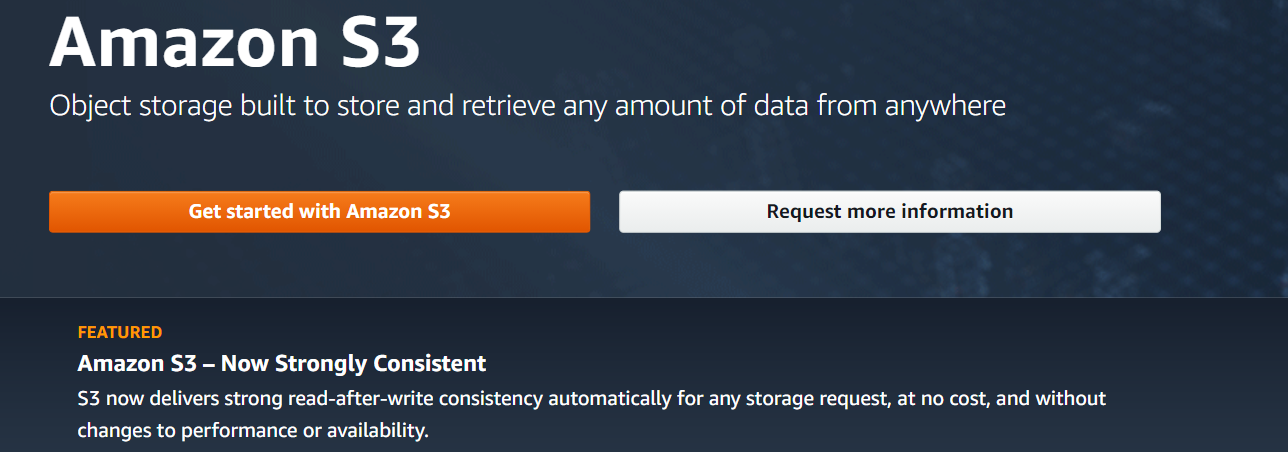

Top 9 AWS Features for Web Developers: Recently Announced
source link: https://blog.bitsrc.io/top-9-aws-features-for-web-developers-recently-announced-16e54649d0a1
Go to the source link to view the article. You can view the picture content, updated content and better typesetting reading experience. If the link is broken, please click the button below to view the snapshot at that time.
Top 9 AWS Features for Web Developers: Recently Announced
Top improvements and features useful in web application development in early 2021

Amazon Web Services(AWS) makes life easier for developers by providing them numerous cloud products and services which can be used to save time in building web and mobile applications.
AWS continuously improve the existing services and release new cloud services all the time. AWS re:Invent is the annual event where they unveil the latest services and improvements to the world.
This article will discuss the latest announcements made at the recent AWS re:Invent event, which are useful for web developers.
Amplify Admin UI
AWS Amplify announced its new Admin UI that allows developers to easily configure an application backend and manage app users and content outside the AWS console. After initial deployment, developers can use the Admin UI even without an AWS account. Team members who do not have AWS accounts can be invited to join the Admin UI via any of their email addresses.
You can easily create your application data models and define relationships among those models using the Amplify Admin UI
The Admin UI provides tools to model database tables, add authentication and authorization, and manage app content, users, and groups.


Since Amplify also allows you to connect the frontend code from a Git repository, developers can accelerate the development and management of full-stack web and mobile apps using the Admin UI.
AWS SDK for JavaScript Version 3
AWS introduced their new SDK for JavaScript v3 with modularization improvements that help reduce your application bundle size. It’s a rewrite of v2 with some great new features besides modularization, such as first-class TypeScript support and a new middleware stack.
Modularized packages allow developers to use a separate package for each service, and the middleware stack makes it possible to control an operation call’s lifecycle.
Let’s see a code example of making a service call to DynamoDB using the new SDK in Node.js.
const { DynamoDBClient, ListTablesCommand } = require("@aws-sdk/client-dynamodb");(async () => {
const client = new DynamoDBClient({ region: "us-west-2" });
const command = new ListTablesCommand({});
try {
const results = await client.send(command);
console.log(results.TableNames.join("\n"));
} catch (err) {
console.error(err);
}
})();Middleware stack allows us to modify the request as it flows through multiple stages. Let’s see how to add a custom header using the middleware stack to the DynamoDB client that we created above.
dbclient.middlewareStack.add(
(next, context) => args => {
args.request.headers["Custom-Header"] = "value";
return next(args);
},
{
step: "build"
}
);dbclient.send(new PutObjectCommand(params));
Tip: Autor, version, and share independent components with Bit (Github).
Use Bit to build modular design systems, collaborate on micro frontends or simply share components between applications.
Bit’s latest beta release: https://harmony-docs.bit.dev/Aurora Serverless v2

At high traffic situations, Aurora Serverless V2 can scale up in miliseconds whereas the V1 takes seconds to scale
Amazon Aurora Serverless is an on-demand, auto-scaling configuration for Amazon Aurora, a cloud-based, MySQL and PostgreSQL-compatible relational database. Aurora Serverless enables you to run your database in the cloud without managing any database capacity. But Aurora Serverless v1 takes a few seconds to scale up. This means that every time a database call comes in after a low traffic period, the first call would take a few seconds, and this is called a cold start.
Aurora Serverless v2 scales up in milliseconds. At the conference, the Aurora Serverless team said that v2 is faster than v1 when it comes to the cold start. This is excellent news for developers who need to develop applications where there are lots of traffic spikes.
S3 Strong Consistency and Multi-Destination Replication

S3 is one of the first services launched in AWS and is one of the most popular AWS services today. Developers often use S3 buckets for data storage due to their numerous useful features. In the reinvent event, AWS announced a feature enhancement called S3 Strong Consistency.
Prior to this, S3 used a model called Eventual Consistency. There was a small delay between a PutObject/UpdateObject action and the response you get back in this model. Even though this delay is negligibly short, for many critical applications, that can be costly.
With the new strongly consistent update, all S3 GET, PUT, and LIST operations, as well as operations that change object tags, ACLs, or metadata, are now strongly consistent.
The other new update for AWS S3 is Multi-Destination Replication. It allows developers to replicate data from one source bucket to multiple destination buckets in the same or different AWS Regions. Before this update, developers had to develop their own solution to copy data from one S3 bucket to multiple destinations that could be very time-consuming. Now AWS handles it for you.
New macOS EC2 Instances

AWS has finally given us the macOS EC2 instances. Now developers no longer need to run emulators or virtual machines to test their apple applications and can finally do so with native apple hardware.
The instances use a combination of Mac mini hardware and the AWS Nitro abstraction layer, which allows macOS 10.14 Mojave and 10.15 Catalina instances to consume other AWS services such as S3, EBS, and EFS.
You can use Amazon EC2 Mac instances to build, test, package, and sign Xcode applications for the Apple platform including macOS, iOS, iPadOS, tvOS, watchOS, and Safari ~ Jeff Barr.

Amazon ECS and EKS Anywhere
Docker is one of the most popular containerization products that is used by web developers today. Amazon’s Elastic Container Service (ECS) is compatible with Docker and allows you to run containerized applications on EC2 instances. With ECS Anywhere, you no longer have to run the containers on AWS servers. You can run them on your machines. The control plane would still be running on the clouds, making it easy to use just like before.

Amazon’s Elastic Kubernetes Service (EKS) gives you the flexibility to start, run, and scale Kubernetes applications in the AWS cloud. With the EKS Anywhere extension, you can now install and use it on any infrastructure.
EKS Anywhere provides an installable software package to build and manage on-site Kubernetes clusters and automation tools for cluster lifecycle support.
EKS Anywhere dramatically simplifies deploying and managing Kubernetes for you.
Amazon Location Service

The newly launched Amazon Location Service makes it easy for developers to add location data to applications. As announced at the conference, the location service is much cheaper than the alternatives available and can obtain location data without sacrificing data security and user privacy.
You can use resources such as Maps, Place Indexes, Trackers, and Geofence Collections in your application with the Amazon Location service.
The Amazon Location Service preview is now free to use and can be accessed from the AWS Management Console, the AWS Command Line Interface (CLI), via a set of APIs, or via existing map libraries such as Mapbox GL and Tangram.

AWS Proton

Many developers are now using container and Serverless computing options for web development. But with smaller and smaller components, deployments are becoming more challenging to manage. AWS Proton is the new solution introduced for this problem.
AWS Proton is the first fully managed application deployment service for container and Serverless applications.
AWS Proton provides platform teams with tools to manage thousands of microservices while performing continuous integration and delivery (CI/CD) configurations. It also allows for enforcing consistent standards. With all this, Proton also makes it easy for developers to use containers and Serverless technologies to deploy their code.
AWS Glue Elastic Views

AWS Glue is a Serverless data integration service. AWS Glue’s new feature, Elastic Views, makes it easy to build materialized views that automatically combine and replicate data across multiple data stores.
Before this feature, if the developer wanted to get their database from DynamoDB to Redshift for analysis, they would have to write custom code. This process would be time-consuming and complicated. Now AWS Elastic Views is taking care of this complexity, so you don’t have to worry about it. All you need to do is select the source and target databases, and migration will happen automatically.
AWS Glue Elastic Views supports many AWS databases and data stores, including DynamoDB, S3, Redshift, and Elasticsearch Service, with support for Amazon RDS, and Aurora.
Conclusion
AWS re:Invent 2020 introduced exciting new services and critical improvements to some existing services. Developers must be aware of them because choosing the right service can determine the success of an application.
To recap, we talked about Amplify Admin UI, AWS SDK for JavaScript Version 3, S3 Strong Consistency and S3 Multi-Destination Replication, Aurora Serverless v2, new macOS EC2 Instances, Amazon EKS Anywhere, Amazon Location Service, AWS Proton, and AWS Glue Elastic Views.
That’s all for this article. Thank you for reading, and happy coding!
Recommend
About Joyk
Aggregate valuable and interesting links.
Joyk means Joy of geeK